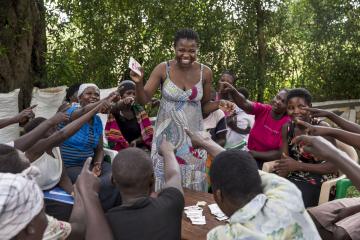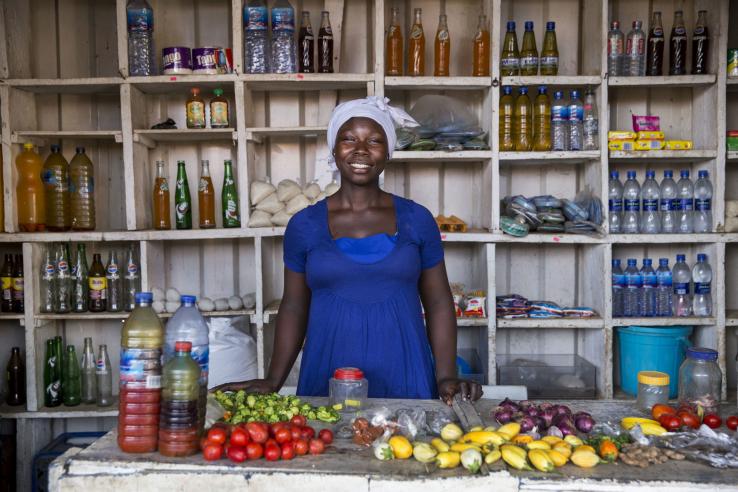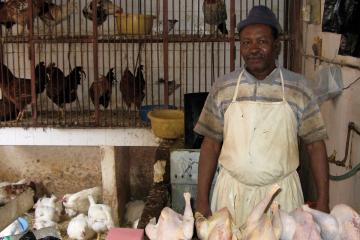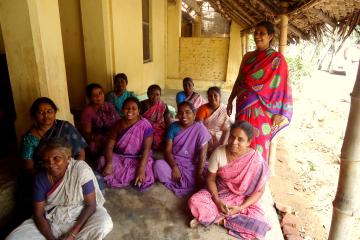
Designing financial services and social protection programs to enhance women’s economic empowerment

Summary
Economic empowerment is an important process through which individuals acquire the ability to generate income, participate in the labor market, control resources, and make economic decisions.1 Yet, women often have more limited economic opportunities compared to men. Around the world, fewer than half (48 percent) of women participate in the labor force compared to three quarters of men.2 Additionally, women’s annual income is just over half of what men earn (US$11,000 compared to US$21,000).3 Therefore, financial inclusion and social protection programs often provide women with microcredit, savings accounts, or cash transfers as a strategy to promote women’s economic empowerment in low-resource settings alongside other economic objectives. The effectiveness of these interventions rests on several assumptions, namely that increased access to financial resources and services will increase women’s income, and that women will have control over the use of funds within the household. Without these conditions, financial inclusion and social protection programs may have limited effects on women’s economic empowerment.
A review of 35 randomized evaluations and quasi-experimental studies in 20 low- and middle-income countries found that access to financial resources or services did not consistently enhance women’s economic empowerment. This was in part due to restrictive gender norms and household dynamics that limited women’s ability to benefit from and direct the use of the funds. Design features—like direct deposits, mobile payments, and commitment savings accounts—that gave women more control over the use of financial resources and enabled them to protect resources from the demands of others improved women’s economic empowerment. Policymakers delivering financial inclusion and social protection programs in contexts where women lack power over household resources should consider employing design features that enhance women’s control.
Supporting evidence
Access to microcredit or savings products did not consistently increase women’s income. Six of the fifteen evaluations of microcredit or savings groups found that access to financial services had small, positive impacts on some business outcomes such as the likelihood that women started a business (e.g., by 22–120 percent in Mongolia [1] and Pakistan [2]), how much they spent on business investments (39 percent in India [3]), and how much revenue their business generated (27 percent in Mexico [4]) [5], [6]. However, none of the studies found increases in women’s income. For example, in Mexico, women with access to microcredit increased business revenue and expenses by 27 and 36 percent, respectively, but this did not lead to increased income [4]. Likewise, access to savings groups of mostly women in Malawi, Ghana, and Uganda led households to operate more businesses (a 6.3 percent increase) and for more months (a 8.6 percent increase) but had no impact on household income [6]. Nonetheless, several studies identified positive impacts on household consumption, spending, or assets, which may indicate greater income [1], [7]–[12]. Additionally, the positive impacts on women’s work in some cases may eventually lead women to earn more income [1]–[3], [5]. While financial inclusion products can offer women a tool to invest in businesses or smooth consumption, they do not guarantee meaningful economic gains, an important component of economic empowerment.
Restrictive social norms and household dynamics limited women’s ability to use financial capital to transform their businesses. For example, evidence suggests that social norms that expect husbands to earn more than their wives led women to divert their financial resources to other household members’ businesses. Reanalyzing data from three evaluations in India [13], Ghana [14], and Sri Lanka [15], researchers found that access to business grants or microcredit increased women’s business profits when women were the sole business owners in the household [16]. For these women, profits increased by 81 percent in India, 43 percent in Ghana, and 22 percent in Sri Lanka. However, in households running multiple businesses, access to grants or loans had no effect on women’s businesses in India and Sri Lanka and had smaller impacts in Ghana. These results suggest that women can benefit from financial resources when they are invested in their businesses, which occurs more often when they are the sole entrepreneur in their household; however, when there are multiple businesses, women’s financial resources are often invested into their husband’s business rather than their own. In India, for example, providing loans to women who lived with other entrepreneurs had no impact on their own businesses but increased business profits for other household members by 44 percent.
Additionally, gender norms related to women’s interactions with people outside of the household limited the success of women-owned businesses in Pakistan. Offering women entrepreneurs loans and training to start a business did not help more women sustain their new businesses [2]. Two factors may have hindered the growth of women’s businesses: 1) women preferred to receive business advice from their partners rather than experts outside their home, and 2) both men and women also preferred women to run businesses from home even if this limited profits.
Finally, partner relationships also affected how women benefited from entrepreneurship programs. For example, women in Uganda who reported that their partners did not treat them well experienced no gains in income from access to a bundle of services including a business grant, while women with better relationships doubled their income [17]. Women may resort to hiding money from spouses to retain control and to prevent other family members from appropriating their resources. A different study in Uganda found that access to loans and trainings had no impact on female entrepreneurs’ profits on average [18]. However, women who hid money from their spouses had positive gains on an index of economic outcomes, including household assets, income, and expenditure; conversely, women who did not hide money had large decreases [19]. When designing programs, policymakers should take into account restrictive social norms and household dynamics that may hinder intended impacts and obstruct women’s ability to benefit from financial interventions.
Most of the interventions that provided women access to credit, savings, or cash and asset transfers also failed to consistently improve women's household decision-making power. The ability to make economic decisions and act on them is a key aspect of economic empowerment. Yet, only four of the fifteen studies of financial inclusion and social protection programs that measured women’s household decision-making power found positive effects. Access to microcredit programs increased women’s participation in household decision-making in Mexico [4] and Nigeria [20] but did not have an effect in India [3], Pakistan [2], or South Africa [12]. Similarly, access to savings groups or self-help groups enhanced women’s household decision-making power in India [11],4 Ghana, Malawi, and Uganda [6] but not in Mali [7], with another study in India finding negative effects [21]. These inconsistent effects could be in part due to the lack of transformative impacts on women’s income. However, the multifaceted Graduation approach—a program that combines a large asset transfer, trainings, consumption support, and savings options to kick-start productive self-employment—increased women’s incomes in most contexts where evaluated (i.e., Afghanistan, Bangladesh, Ethiopia, Ghana, Honduras, India, Pakistan, and Peru) but did not have lasting impacts on women’s household decision-making power [22]–[24].5 In several contexts, women did work more, like in Pakistan [2], India [3], and across the Graduation studies [22]-[24], which may reflect improved economic empowerment despite more limited impacts on decision-making power.
Overall, these mixed effects across microcredit, savings groups, and the Graduation approach could be explained by measurement issues related to decision-making, details in program implementation and delivery, and/or context-specific gender relations. Nonetheless, these studies illustrate that providing women access to financial resources and products does not always enhance their control over economic decisions, thus limiting impacts on women’s economic empowerment.
Transferring funds through direct deposits to women’s accounts or mobile payments gave women more control over the use of financial resources and improved economic empowerment. In India, depositing wage payments for a federal workfare program directly to women’s bank accounts and training women on the benefits of the accounts increased the likelihood that women worked [25]. Strengthening women’s control over their income seemed to enhance their bargaining power and empowered them to push back against restrictive gender norms. The intervention led women to hold more liberal attitudes toward women’s work and improved women’s mobility, as more women reported visiting common public places, like markets and health centers. Effects were even greater for women whose family members had strong attitudes against women’s work and for those who never before worked for the federal workfare program.
Along the same lines, mobile payments, relative to cash, may offer privacy and enable women to protect their resources and maintain financial control. In Niger, distributing cash transfer payments through mobile money instead of cash increased women’s participation in economic activities, such as visiting the market (74 percent) and selling grains for her household (40 percent) [26]. Likewise, in Uganda, microfinance loans to female borrowers distributed through mobile money, as opposed to in cash, increased business profits by 15 percent, with the greatest impacts for women who experienced pressure to share money with their spouse [27]. When the mobile money infrastructure exists, digital delivery of financial resources seems promising to promote women’s economic empowerment.
Savings accounts that offered commitment devices or were costly to access protected women’s funds against the demands of others. In the Philippines, access to a commitment savings account, which restricted withdrawals until reaching a prespecified date or balance, increased women’s power over household decisions [28]. These commitment savings accounts were particularly effective for women who had initially lower levels of decision-making power. Likewise, married women were more likely than single women to use other types of commitment savings devices, including deposit collection services in the Philippines [29] and locked boxes in Kenya [30]. Finally, when offered a free bank account with no interest and large withdrawal fees, 40 percent of female market vendors in rural Kenya used their account and had a nearly sixfold increase in daily savings [31]. In contrast, few of the men who were offered an account used it, as they likely already had better alternatives for saving. The relatively high withdrawal fees, which served as a commitment to avoid spending saved funds, may have helped women protect their savings against pressures to share resources with family or friends.
Conversely in Kenya, offering ATM cards that increased the accessibility and reduced the costs of using savings accounts led women with low levels of decision-making power relative to their spouses to stop using their accounts [32]. In this case, making the account easier to access through ATM cards also made these accounts less attractive to women with lower-bargaining power, who may have used the accounts to hide money from their spouses. In settings where women struggle to maintain control over financial resources, accounts with commitment features or that make funds harder to access can be effective in helping women protect and retain control.
Design features can enhance women’s control over financial resources that may be hindered by household power dynamics. When delivering financial inclusion and social protection programs, policymakers should consider design features that give women more control over receiving and accessing financial resources. Yet, there is no one-size-fits-all option. For example, features that restrict people’s access to their own financial resources (e.g., commitment savings accounts) may enhance control, but they may also pose inconveniences to use funds. Alternatively, features that give women control over how they receive the funds (e.g., direct deposits or mobile money) may offer women more flexibility in how they access and use resources, but this also requires the infrastructure for digital transfers. Nonetheless, many of these approaches try to work around restrictive gender norms, for instance, by allowing women to hide money from their family members. More research is needed on programs that intentionally aim to address restrictive gender norms and change power relations in the household.
Abdul Latif Jameel Poverty Action Lab (J-PAL). 2021. "Designing financial services and social protection programs to enhance women’s economic empowerment." J-PAL Policy Insights. Last modified Feburary 2021. https://doi.org/10.31485/pi.3090.2021.
Laszlo, Sonia, Kate Grantham, Ecem Oskay, and Tingting Zhang. 2020. “Grappling with the Challenges of Measuring Women’s Economic Empowerment in Intrahousehold Settings.” World Development 132 (August): 104959. https://doi.org/10.1016/j.worlddev.2020.104959.
International Labour Organization. 2019. “Labor Force Participation Rate, Female (% of Female Population Ages 15+) (Modeled ILO Estimate).” ILOSTAT database. [Online]. Available at https://data-worldbank-org.libproxy.lib.unc.edu/indicator/SL.TLF.CACT.FE.ZS. [Accessed: 22-Jul-2019].
World Economic Forum. 2019. “Global Gender Gap Report 2020.” World Economic Forum, Geneva, Switzerland.
While there were positive impacts on women’s decision-making power, effects were minimal on other dimensions of women’s bargaining power, like asset ownership or labor force participation.
In Afghanistan, researchers found positive impacts on women’s empowerment when measured by an expanded index that captured more dimensions of empowerment, like women’s participation in decisions over their body and time, access to resources, and economic opportunities, in addition to the commonly used measure of women’s participation in decisions over household spending.
Attanasio, Orazio, Britta Augsburg, Ralph De Haas, Emla Fitzsimons, and Heike Harmgart. 2015. “The Impacts of Microfinance: Evidence from Joint-Liability Lending in Mongolia.” American Economic Journal: Applied Economics 7 (1): 90–122. Research Paper | J-PAL Evaluation Summary
Said, Farah, Mahreen Mahmud, Giovanna D’adda, and Azam Chaudhry. “Home-Bias among Female Entrepreneurs: Experimental Evidence on Preferences from Pakistan.” CREB Working Paper #04-20, March 2020. Research Paper
Banerjee, Abhijit, Esther Duflo, Rachel Glennerster, and Cynthia Kinnan. 2015. “The Miracle of Microfinance? Evidence from a Randomized Evaluation.” American Economic Journal: Applied Economics 7 (1): 22–53. Research Paper | J-PAL Evaluation Summary
Angelucci, Manuela, Dean Karlan, and Jonathan Zinman. 2015. “Microcredit Impacts: Evidence from a Randomized Microcredit Program Placement Experiment by Compartamos Banco.” American Economic Journal: Applied Economics 7 (1): 151–182. Research Paper | J-PAL Evaluation Summary
Desai, Raj M. and Shareen Joshi. 2014. “Collective Action and Community Development: Evidence from Self-Help Groups in Rural India.” The World Bank Economic Review 28 (3): 492–524. Research Paper
Karlan, Dean, Beniamino Savonitto, Bram Thuysbaert, and Christopher Udry. 2017. “Impact of Savings Groups on the Lives of the Poor.” Proceedings of the National Academy of Sciences of the United States of America 114 (12): 3079–3084. Research Paper
Beaman, Lori, Dean Karlan, and Bram Thuysbaert. “Saving for a (Not So) Rainy Day: A Randomized Evaluation of Savings Groups in Mali.” NBER Working Paper #20600, October 2014. Research Paper | J-PAL Evaluation Summary
Annan, Jeannie, Tom Bundervoet, Juliette Seban, and Jaime Costigan. 2013. “A Randomized Impact Evaluation of Village Savings and Loans Associations and Family-Based Interventions in Burundi.” New York: International Rescue Committee. Research Paper
Ksoll, Christopher, Helene B. Lilleør, Jonas H. Lønborg, and Ole D. Rasmussen. 2016. “Impact of Village Savings and Loan Associations: Evidence from a Cluster Randomized Trial.” Journal of Development Economics 120 (May): 70–85. Research Paper
Bass, Judith, Sarah Murray, Gabrielle Cole, Paul Bolton, Catherine Poulton, Katie Robinette, Juliette Seban, Kathryn Falb, and Jeannie Annan. 2016. “Economic, Social and Mental Health Impacts of an Economic Intervention for Female Sexual Violence Survivors in Eastern Democratic Republic of Congo.” Global Mental Health (Cambridge, England) 3 (June): e19. Research Paper
Prillaman, Soledad A. “Strength in Numbers: How Women’s Groups Close India’s Political Gender Gap.” Working Paper, November 2020. Research Paper
Kim, Julia, Giulia Ferrari, Tanya Abramsky, Charlotte Watts, James Hargreaves, Linda Morison, Godfrey Phetla, John Porter, and Paul Pronyk. 2009. “Assessing the Incremental Effects of Combining Economic and Health Interventions: The IMAGE Study in South Africa.” Bulletin of the World Health Organization 87 (11): 824–832. Research Paper
Field, Erica, Rohini Pande, John Papp, and Natalia Rigol. 2013. “Does the Classic Microfinance Model Discourage Entrepreneurship among the Poor? Experimental Evidence from India.” American Economic Review 103 (6): 2196–2226. Research Paper | J-PAL Evaluation Summary
Fafchamps, Marcel, David McKenzie, Simon Quinn, and Christopher Woodruff. 2014. “Microenterprise Growth and the Flypaper Effect: Evidence from a Randomized Experiment in Ghana.” Journal of Development Economics 106: 211–226. Research Paper | J-PAL Evaluation Summary
Mel, Suresh de, David McKenzie, and Christopher Woodruff. 2014. “Business Training and Female Enterprise Start-Up, Growth, and Dynamics: Experimental Evidence from Sri Lanka.” Journal of Development Economics 106: 199–210. Research Paper | J-PAL Evaluation Summary
Bernhardt, Arielle, Erica Field, Rohini Pande, and Natalia Rigol. 2019. “Household Matters: Revisiting the Returns to Capital among Female Microentrepreneurs.” American Economic Review: Insights 1 (2): 141–160. Research Paper | J-PAL Evaluation Summary
Green, Eric P., Christopher Blattman, Julian Jamison, and Jeannie Annan. 2015. “Women’s Entrepreneurship and Intimate Partner Violence: A Cluster Randomized Trial of Microenterprise Assistance and Partner Participation in Post-Conflict Uganda (SSM-D-14-01580R1).” Social Science & Medicine 133 (May): 177–188. Research Paper | J-PAL Evaluation Summary
Fiala, Nathan. 2018. “Returns to Microcredit, Cash Grants and Training for Male and Female Microentrepreneurs in Uganda.” World Development 105 (May): 189–200. Research Paper
Fiala, Nathan. “Business Is Tough, but Family Is Worse: Household Bargaining and Investment Decisions in Uganda.” Working Paper, April 2017. Research Paper
Ikenwilo, Divine, Damilola Olajide, Olufemi Obembe, Ngozi Ibeji, and Rufus Akindola. “The Impact of a Rural Microcredit Scheme Targeting Women on Household Vulnerability and Empowerment: Evidence from South West Nigeria.” PEP Working Paper, January 2016. Research Paper
Hoffmann, Vivian, Vijayendra Rao, Vaishnavi Surendra, and Upamanyu Datta. “Relief from Usury: Impact of a Community-Based Microcredit Program in Rural India.” Policy Research Working Paper #8021, April 2017. Research Paper
Bedoya, Guadalupe, Aidan Coville, Johannes Haushofer, Mohammad Isaqzadeh, and Jeremy Shapiro. “No Household Left Behind: Afghanistan Targeting the Ultra Poor Impact Evaluation.” Policy Research Working Paper #8877, June 2019. Research Paper
Bandiera, Oriana, Robin Burgess, Narayan Das, Selim Gulesci, Imran Rasul, and Munshi Sulaiman. 2017. “Labor Markets and Poverty in Village Economies.” Quarterly Journal of Economics 132 (2): 811–870. Research Paper | J-PAL Evaluation Summary
Banerjee, Abhijit, Esther Duflo, Nathanael Goldberg, Dean Karlan, Robert Osei, William Parienté, Jeremy Shapiro, Bram Thuysbaert, and Christopher Udry. 2015. “A Multifaceted Program Causes Lasting Progress for the Very Poor: Evidence from Six Countries.” Science 348 (6236): 1260799. Research Paper
Field, Erica, Rohini Pande, Natalia Rigol, Simone Schaner, and Charity Troyer Moore. “On Her Own Account: How Strengthening Women’s Financial Control Affects Labor Supply and Gender Norms.” Working Paper, October 2020. Research Paper | J-PAL Evaluation Summary
Aker, Jenny C., Rachid Boumnijel, Amanda McClelland, and Niall Tierney. 2016. “Payment Mechanisms and Antipoverty Programs: Evidence from a Mobile Money Cash Transfer Experiment in Niger.” Economic Development and Cultural Change 65 (1): 1–37. Research Paper | J-PAL Evaluation Summary
Riley, Emma. 2024. “Resisting Social Pressure in the Household Using Mobile Money: Experimental Evidence on Microenterprise Investment in Uganda.” American Economic Review 114, no. 5: 1415–47. Research Paper.
Ashraf, Nava, Dean Karlan, and Wesley Yin. 2010. “Female Empowerment: Impact of a Commitment Savings Product in the Philippines.” World Development 38 (3): 333–344. Research Paper | J-PAL Evaluation Summary
Ashraf, Nava, Dean Karlan, and Wesley Yin. 2006. “Deposit Collectors.” The B.E. Journal of Economic Analysis & Policy 6 (2). Research Paper | J-PAL Evaluation Summary
Dupas, Pascaline and Jonathan Robinson. 2013a. “Why Don’t the Poor Save More? Evidence from Health Savings Experiments.” American Economic Review 103 (4): 1138–1171. Research Paper | J-PAL Evaluation Summary
Dupas, Pascaline and Jonathan Robinson. 2013b “Savings Constraints and Microenterprise Development: Evidence from a Field Experiment in Kenya.” American Economic Journal: Applied Economics 5 (1): 163–192. Research Paper | J-PAL Evaluation Summary
Schaner, Simone. 2017. “The Cost of Convenience? Transaction Costs, Bargaining Power, and Savings Account Use in Kenya.” Journal of Human Resources 52 (4): 919–945. Research Paper | J-PAL Evaluation Summary

